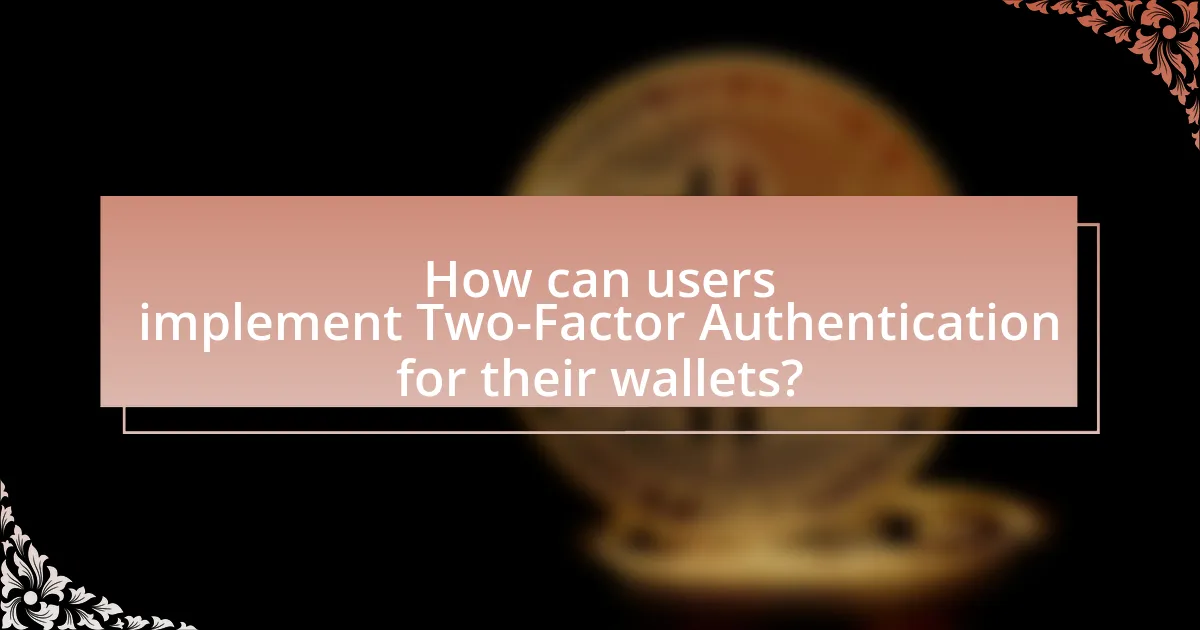Two-Factor Authentication (2FA) is a critical security measure that enhances wallet protection during airdrop transactions by requiring two forms of identification for account access. This article explores the significance of 2FA in safeguarding digital assets, detailing its effectiveness in blocking unauthorized access and automated attacks. Key components of 2FA, various authentication methods, and the importance of wallet security in the context of airdrops are discussed, alongside best practices for users to implement and maintain robust security measures. Additionally, the article addresses potential vulnerabilities and troubleshooting tips related to 2FA, emphasizing the necessity of secure wallet practices to prevent financial loss during airdrop events.

What is Two-Factor Authentication and its Role in Wallet Security for Airdrops?
Two-Factor Authentication (2FA) is a security process that requires two different forms of identification to access an account, significantly enhancing wallet security for airdrops. By combining something the user knows, like a password, with something the user has, such as a mobile device for receiving a verification code, 2FA reduces the risk of unauthorized access. According to a study by Google, implementing 2FA can block 99.9% of automated attacks, demonstrating its effectiveness in protecting digital assets during airdrop transactions.
How does Two-Factor Authentication enhance wallet security?
Two-Factor Authentication (2FA) enhances wallet security by requiring two forms of verification before granting access, significantly reducing the risk of unauthorized access. This method combines something the user knows, like a password, with something the user has, such as a mobile device for receiving a one-time code. According to a study by Google, implementing 2FA can block 99.9% of automated attacks, demonstrating its effectiveness in protecting sensitive information, including cryptocurrency wallets.
What are the key components of Two-Factor Authentication?
The key components of Two-Factor Authentication (2FA) are something you must understand for enhanced security. 2FA requires two distinct forms of identification to verify a user’s identity, typically combining something the user knows (like a password) with something the user has (like a mobile device or hardware token). This dual-layer approach significantly reduces the risk of unauthorized access, as an attacker would need both components to gain entry. According to a study by Google, implementing 2FA can block 99.9% of automated attacks, demonstrating its effectiveness in safeguarding sensitive information.
How does Two-Factor Authentication protect against unauthorized access?
Two-Factor Authentication (2FA) protects against unauthorized access by requiring two distinct forms of verification before granting access to an account. This process typically involves something the user knows, like a password, and something the user has, such as a mobile device that receives a one-time code. By implementing this dual-layer security, even if an attacker obtains the password, they cannot access the account without the second factor, significantly reducing the risk of unauthorized access. According to a study by Google, 2FA can block 100% of automated bots and 96% of phishing attacks, demonstrating its effectiveness in enhancing security.
Why is wallet security crucial for airdrops?
Wallet security is crucial for airdrops because it protects users from unauthorized access and potential loss of funds. Airdrops often involve the distribution of tokens to users’ wallets, making them targets for hackers who exploit weak security measures. For instance, in 2020, a significant number of users lost funds during airdrop events due to phishing attacks that compromised wallet security. Implementing robust security measures, such as two-factor authentication, significantly reduces the risk of unauthorized access, ensuring that users can safely receive and manage their airdropped tokens.
What risks are associated with insecure wallets during airdrops?
Insecure wallets during airdrops pose significant risks, including the potential for unauthorized access and theft of funds. When wallets lack robust security measures, such as two-factor authentication, they become vulnerable to hacking attempts, phishing attacks, and malware. For instance, a study by the Blockchain Security Alliance found that over $1.9 billion was lost to hacks in 2020, with many incidents attributed to inadequate wallet security. This highlights the critical need for secure wallet practices to protect assets during airdrops.
How can compromised wallets affect airdrop participants?
Compromised wallets can significantly affect airdrop participants by exposing their private keys and allowing unauthorized access to their funds. When a wallet is compromised, attackers can intercept airdrop tokens intended for the legitimate owner, redirecting them to their own accounts. This not only results in financial loss for the affected participants but also undermines the integrity of the airdrop process, as it can lead to a decrease in trust among potential participants. According to a report by Chainalysis, in 2021, over $7.7 billion was stolen from cryptocurrency wallets, highlighting the risks associated with inadequate wallet security measures, such as the absence of two-factor authentication.

What are the different types of Two-Factor Authentication methods?
The different types of Two-Factor Authentication (2FA) methods include SMS-based authentication, authenticator apps, hardware tokens, biometric verification, and email-based authentication. SMS-based authentication sends a one-time code via text message, while authenticator apps generate time-based codes on a mobile device. Hardware tokens are physical devices that produce codes, and biometric verification uses unique physical characteristics, such as fingerprints or facial recognition, for authentication. Email-based authentication sends a verification link or code to the user’s email. Each method enhances security by requiring a second form of verification beyond just a password, making unauthorized access significantly more difficult.
How do SMS-based and app-based authentication differ?
SMS-based authentication sends a one-time code to a user’s mobile phone via text message, while app-based authentication generates a time-sensitive code within a dedicated application on the user’s device. SMS-based methods are vulnerable to interception and SIM swapping attacks, as evidenced by a 2019 study from the University of California, which highlighted that SMS can be compromised more easily than app-based methods. In contrast, app-based authentication, such as Google Authenticator or Authy, operates offline and is less susceptible to such attacks, providing a more secure option for two-factor authentication in wallet security for airdrops.
What are the advantages and disadvantages of SMS-based authentication?
SMS-based authentication offers advantages such as convenience and widespread accessibility, allowing users to receive one-time codes on their mobile devices quickly. This method is easy to implement for both users and service providers, as it requires minimal technical infrastructure. However, disadvantages include vulnerability to interception through techniques like SIM swapping and phishing attacks, which can compromise security. According to a 2020 report by the Cybersecurity and Infrastructure Security Agency, SMS-based authentication is considered less secure than other methods, such as app-based or hardware token authentication, due to these risks.
How does app-based authentication improve security?
App-based authentication improves security by providing a second layer of verification beyond just a password. This method requires users to confirm their identity through a mobile application, which generates time-sensitive codes or utilizes biometric data, making unauthorized access significantly more difficult. According to a study by Google, implementing two-factor authentication can block up to 99.9% of automated attacks, demonstrating its effectiveness in enhancing security measures.
What role does biometric authentication play in wallet security?
Biometric authentication significantly enhances wallet security by providing a unique and personal method of verifying user identity. This technology utilizes physical characteristics, such as fingerprints or facial recognition, which are difficult to replicate or steal compared to traditional passwords. According to a study by the National Institute of Standards and Technology, biometric systems can reduce the risk of unauthorized access, as they rely on traits that are inherently tied to the individual. This makes it a robust layer of security in the context of wallet protection, especially for sensitive transactions like airdrops.
How effective is biometric authentication compared to traditional methods?
Biometric authentication is significantly more effective than traditional methods, such as passwords or PINs, due to its unique ability to leverage individual physiological traits for verification. Studies indicate that biometric systems, like fingerprint or facial recognition, have a false acceptance rate of less than 0.1%, while traditional methods can have much higher rates of compromise, with 81% of data breaches involving weak or stolen passwords. This stark contrast highlights the enhanced security provided by biometric authentication, making it a superior choice for protecting sensitive information in contexts like wallet security for airdrops.
What are the potential vulnerabilities of biometric systems?
Biometric systems are vulnerable to several potential threats, including spoofing, data breaches, and system errors. Spoofing occurs when an attacker uses fake biometric traits, such as silicone fingerprints or high-resolution images, to gain unauthorized access. Data breaches can expose biometric data, which is often stored in centralized databases, making it susceptible to hacking. Additionally, system errors may lead to false rejections or acceptances, compromising the reliability of biometric authentication. According to a study published in the journal “IEEE Transactions on Information Forensics and Security,” biometric systems can be particularly vulnerable to these attacks due to the unique nature of biometric data, which, once compromised, cannot be changed like a password.

How can users implement Two-Factor Authentication for their wallets?
Users can implement Two-Factor Authentication (2FA) for their wallets by enabling it through the wallet’s security settings. Most cryptocurrency wallets provide an option to activate 2FA, typically requiring users to link their wallet to an authentication app, such as Google Authenticator or Authy, or to receive SMS codes. This process enhances security by requiring a second form of verification in addition to the password, significantly reducing the risk of unauthorized access. According to a study by the Cybersecurity & Infrastructure Security Agency, enabling 2FA can prevent 99.9% of automated attacks, underscoring its effectiveness in safeguarding digital assets.
What steps should users follow to enable Two-Factor Authentication?
To enable Two-Factor Authentication (2FA), users should follow these steps: First, access the security settings of the account they wish to protect. Next, locate the Two-Factor Authentication option and select it. Users will then be prompted to choose a method for receiving the second factor, such as a text message, authentication app, or email. After selecting the preferred method, users must follow the on-screen instructions to verify their choice, which typically involves entering a code sent to their chosen method. Finally, users should save the changes to activate 2FA, ensuring their account is now more secure against unauthorized access.
What common mistakes should users avoid during setup?
Users should avoid using weak passwords during setup, as this significantly compromises wallet security. Weak passwords are easily guessable and can be cracked using brute-force attacks, leading to unauthorized access to funds. Additionally, users should not skip enabling two-factor authentication (2FA), which adds an extra layer of security by requiring a second form of verification. Failing to back up recovery phrases or keys is another critical mistake, as losing access to these can result in permanent loss of funds. Lastly, users should avoid ignoring software updates, as these often contain important security patches that protect against vulnerabilities.
How can users ensure their Two-Factor Authentication remains secure?
Users can ensure their Two-Factor Authentication (2FA) remains secure by utilizing strong, unique passwords and enabling 2FA methods that are less susceptible to phishing attacks, such as authenticator apps instead of SMS. Strong passwords reduce the risk of unauthorized access, while authenticator apps generate time-sensitive codes that are more secure than SMS codes, which can be intercepted. According to a study by Google, using 2FA can block 100% of automated bots and 96% of bulk phishing attacks, demonstrating its effectiveness when properly implemented.
What best practices should users follow for wallet security during airdrops?
Users should enable two-factor authentication (2FA) for their wallets during airdrops to enhance security. 2FA adds an extra layer of protection by requiring a second form of verification, such as a code sent to a mobile device, in addition to the password. This significantly reduces the risk of unauthorized access, as even if a password is compromised, the attacker would still need the second factor to gain entry. According to a study by Google, accounts with 2FA are 100% more secure against phishing attacks, highlighting the effectiveness of this practice in safeguarding digital assets during events like airdrops.
How can users verify the legitimacy of airdrops before participation?
Users can verify the legitimacy of airdrops by conducting thorough research on the project and its team. This includes checking the project’s official website, social media channels, and community forums for credible information. Additionally, users should look for verified partnerships, endorsements from reputable figures in the cryptocurrency space, and a clear whitepaper outlining the project’s goals and technology. According to a report by Cointelegraph, over 80% of airdrops are associated with scams, highlighting the importance of due diligence before participation.
What additional security measures can complement Two-Factor Authentication?
Additional security measures that can complement Two-Factor Authentication (2FA) include the use of strong, unique passwords, regular software updates, and biometric authentication. Strong, unique passwords reduce the risk of unauthorized access, as studies show that 81% of data breaches are linked to weak passwords. Regular software updates ensure that vulnerabilities are patched, enhancing overall security. Biometric authentication, such as fingerprint or facial recognition, adds an extra layer of security by requiring physical traits for access, making it significantly harder for attackers to gain entry.
What troubleshooting tips can help users with Two-Factor Authentication issues?
To resolve Two-Factor Authentication (2FA) issues, users should first verify that their device’s time and date settings are accurate, as discrepancies can prevent authentication codes from being accepted. Additionally, users should ensure they are using the correct authentication method, whether it be an app like Google Authenticator or receiving SMS codes, and check for any connectivity issues that may hinder code delivery. If problems persist, users can try resetting their 2FA settings through their account’s security options or contacting customer support for assistance. These steps are effective because accurate time settings and correct methods are critical for the proper functioning of 2FA systems.


